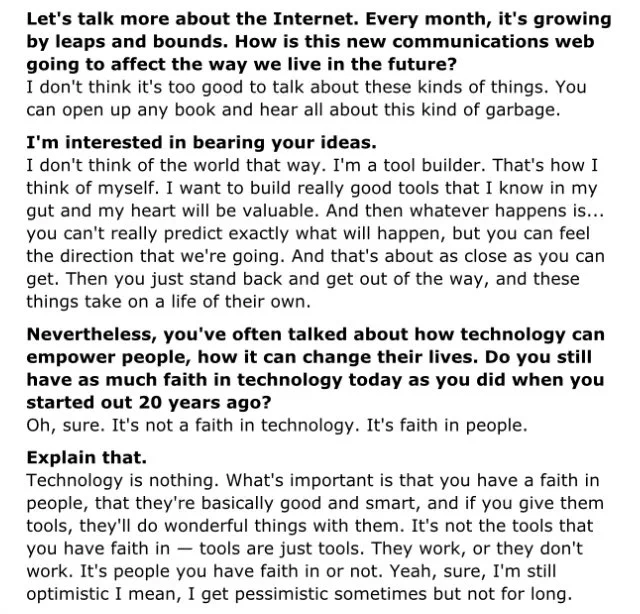How it's like watching (or reading, or interacting with ) something you know you'll certainly enjoy?
That have no trailers and you know almost nothing about
That , in most cases, no one will watch it but you
We never consumer media like this
I imagine the next media trend is media generation on demand that you will certainly like based on a lot of signals and the data you choose (or not ) to give
I am interested in reading opinions on this
"The one who pushed for sora is an artist, so sora is necessarily great for artists "
i think your error here is thinking sora and adult content are some leadership master plan; that sama sat down with accountants and signed and said “it’s time to break glass for emergence revenue” no.
i know the exact people who pushed for sora, they’re artists who worked against organizational headwinds to democratize movie creation, something they love dearly. i know the exact person who pushed for adult content, they’re a professional athlete, free-sprinted, one of the most socially thoughtful people i know… who just really believes in creative freedom.
there are passionate individual who pushed against all odds for what you think are top-down decisions. we are not a monoculture, and i love that.
mdj retweeted
They are actually Love America rallies, Mike. Ordinary people, man, trying to save the country from a despot.
It turns out the “Hate America” Rallies tomorrow are being funded by the billionaire who hates America the MOST. Anyone surprised?
foxnews.com/politics/soros-f…
mdj retweeted
You can't get excited for new technologies when the world is led by those who don’t have humanity’s best interests at heart.
mdj retweeted
This is exactly how I feel
For some reason, every founder, every ceo feels the need to tell us how the world will look in a few years or decades. 99% of them are just spouting nonsense.
mdj retweeted
Who defines what's "rude " , "dumb" and "offensive"?
This is the problem
With Kimmel getting canned I’m seeing lots of people talking about the hypocrisy of cancel culture. To me Cancel culture is when people go out of their way to dig up old tweets, videos etc looking for dirt on somebody they don’t like in an effort to get them fired. Like if Kimmel got canceled for shit he did on the Man Show that would be cancel culture. But when a person says something that a ton of people find offensive, rude, dumb in real time and then that person is punished for it that’s not cancel culture. That is consequences for your actions
mdj retweeted
Life gets easier when you realize that most people are clueless, most people don't matter, and everyone’s got a side you wouldn’t like.
mdj retweeted
"people tend to overestimate what technology can achieve in one year, and underestimate what it can achieve in ten."
Knowing the endgame is useless; what matters is the path. This is especially true for the VR/AR industry.
It will take a long time for VR/AR to mature. The real value lies in figuring out what to do at each step. Since technology can’t be fully mature from the start, we must constantly search for the best balance between form and capability.
Early VR headsets overestimated users’ tolerance for bulky designs and were quickly corrected by the market. The glasses route, on the other hand, underestimated the appeal of the glasses form factor—so much so that something like Ray-Ban Meta, with just a few added functions, can sell very well.
The problem is that people tend to swing to extremes: sometimes over-ignoring form, sometimes over-emphasizing it.
Right now, I feel the pendulum is swinging toward over-emphasizing form. In the next two years, we may see a wave of glasses that look sleek but sacrifice too much capability, leading to disappointing user experiences. Meanwhile, some powerful VR headsets might actually be underrated.
Objectively speaking, both form and capability are important. There’s no shortcut; only time and technological progress can fuse the two together. But human nature always prefers shortcuts and leaps.
As the saying goes, people tend to overestimate what technology can achieve in one year, and underestimate what it can achieve in ten.
mdj retweeted
overreacted.io/open-social/
Over social.
This is great
I hope I can be part of that future.
mdj retweeted
End suffering and hatred. Protect the vulnerable, uplift the oppressed, and ensure every person can live with dignity, freedom, and hope.
Ai is destroying our world quietly and the governments are not trying to find meaningful solutions
This makes me question capitalism.
mdj retweeted
🚨NEW: The Massachusetts Institute of Technology (MIT) has rejected the Trump Administration’s offer of federal funding in exchange for aligning with Trump’s agenda. This is the first university to do so.
RETWEET to thank MIT President Sally Kornbluth for standing up to Trump!
mdj retweeted
The world’s richest man agrees that AI will wipe out millions of jobs, destroy the arts, make us lose trust in what we see, and destroy civilization -
- and says the best he can do about it is make his own AI that doesn’t want “to turn everyone into diverse women”.
1. What
Israel Agrees To Go Back To Killing Palestinians On Less Frequent Basis theonion.com/israel-agrees-t…















